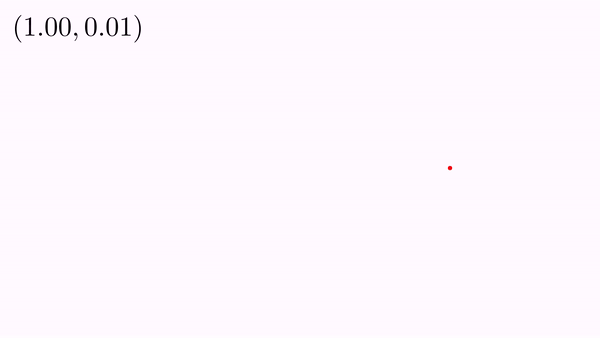jmathanim
A Java library to make mathematical animations
Project maintained by davidgutierrezrubio Hosted on GitHub Pages — Theme by mattgraham
Dynamic Text and Linking MathObjects
The method setLatex() of the LatexMathObject allows to change and recompile the LaTeX code, but there is another way to add text that changes its content while animating, using the Link class. Let’s see this with an example. Suppose you have the following code in the runSketch() method, that rotates a red point along the unit circumference:
Point A=Point.at(1,0).thickness(30).drawColor("red");
play.rotate(5,Point.origin(),2*PI,A);
Suppose you want to show the coordinates of the point while the point moves. This can be accomplished advancing each frame and doing the proper changes to the LatexMathObject:
//The format I will use to represent the coordinates.
//2 decimal places. Use point as decimal separator
DecimalFormat df=new DecimalFormat("0.00");
df.setDecimalFormatSymbols(DecimalFormatSymbols.getInstance(Locale.UK));
Point A = Point.at(1, 0).thickness(30).drawColor("red");
Animation anim = Commands.rotate(5, Point.origin(), 2 * PI, A);
//The LEFT parameter says that, when changing text, the new text should be
//stacked to the left part of the old text (the default value is CENTER)
LatexMathObject text = LatexMathObject.make("$(1,0)$",AnchorType.LEFT);
//Put the text in the upper left screen corner
text.stack().toScreen(ScreenAnchor.UPPER_LEFT);
add(text);
anim.initialize(this);
while (!anim.processAnimation()) {//Main animation loop
//Update the text with the new coordinates
text.setLaTeX("$(" + df.format(A.v.x) + ", " + df.format(A.v.y)+ ")$");
advanceFrame();
}
You will have the following animation:

We will see another way to get this effect, using the Linkclass
Linking objects
A link is a method that is called immediately after the objects have been updated with the update() method and prior to render them. Basically, it gets an attribute of the “from” object and puts it in the “destiny” object.
We illustrate this with an example:
Point A = Point.at(1, 0).thickness(30).drawColor("red");
//The LEFT parameter says that, when changing text, the new text should be
//stacked to the left part of the old text (the default value is CENTER)
LatexMathObject text = LatexMathObject.make("$({#0},{#1})$", AnchorType.LEFT);
registerLink(A, //From object A...
LinkType.X, //...take the X coordinate...
text, //and put it in the object text...
LinkType.ARG0 //in its first argument
);
registerLink(A, //From object A...
LinkType.Y, //...take the Y coordinate...
text, //and put it in the object text...
LinkType.ARG1 //in its second argument
);
//Put the text in the upper left screen corner
text.stack().toScreen(ScreenAnchor.UPPER_LEFT);
add(text);
play.rotate(5, Point.origin(), 2 * PI, A);
If you execute this code you will get the same result as before. Lets see what code we used. Look at the LaTeX code in the LatexMathObject:
LatexMathObject text = LatexMathObject.make("$({#0},{#1})$", Anchor.Type.LEFT);
The coordinates have now been replaced by the strings {#0} and {#1}. These are special escape strings that instruct JMathAnim to replace them with the values of the first and second arguments, respectively. In fact, a LatexMathObject can hold up to ten arguments, named {#0} to {#9}.
The set of this argument is done via the linking process. To do so, we must create and register a link in the scene flow. This is done with this command:
registerLink(A, //From object A...
LinkType.X, //...take the X coordinate...
text, //and put it in the object text...
LinkType.ARG0 //in its first argument
);
The comments tell how it works. The first parameter is the source object, where to extract the information. The second parameter is a LinkType enum that defines the type of information. Depending on the object type and this value a certain value is extracted, and JMathAnim do its best to extract the appropriate information. For example in this case, X coordinate of the point is extracted. If A were a MathObjectGroupfor example, the x coordinate of the center of the object will be extracted.
The third and fourth parameters define the destiny object and the type of attribute to change in this object. In this case the value ARG0 means to change the value of the first argument.
Currently, the following LinkType values are supported:
public enum LinkType {
X, Y, //Coordinates of a Point or the center of a MathObject
VALUE, //If a vector, returns its norm. If a Mathobject, the distance from the origin to its center
COUNT, //If a MathObjectGroup, returns the number of elements. If Shape, number of points
WIDTH, HEIGHT, XMIN, XMAX, YMIN, YMAX,//Return these values from the Bounding Box of the object
ARG0, ARG1, ARG2, ARG3, ARG4, ARG5, ARG6, ARG7, ARG8, ARG9 //Arguments of a LatexMathObject
};